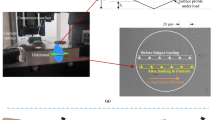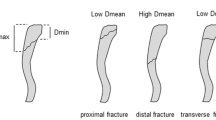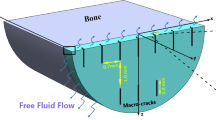Summary
Tibiae from 60 male Wistar rats, aged 13 ±1 weeks, were divided into six groups for mechanical and histological testing. Bones were loaded repetitively in torsion at 90 deg.s−1. Group 1 was subjected to 5,000 loading cycles at a twist angle of 3.6°, groups 2–5 to 10,000 cycles at 3.6, 5.4, 7.2, and 9.0°, respectively, and group 6 was tested to failure. Six transverse sections from the middiaphysis were then cut, bulk-stained in basic fuchsin, and hand ground to 30–50 μm to examine the presence of microcracks. Cracks were classified as running parallel to lamellae, crossing lamellae, crossing the full thickness of the cortex, or invading vascular canals. Results for fatigue testing showed that the tibiae exhibited a gradual decrease in torque (P<0.05), average stress (P<0.01), stiffness (P<0.01) and energy absorbed (P<0.01) from the initial loading cycle. Analysis of microdamage showed an increase in the variety of cracks from groups, 1–5. Analysis of deviance demonstrated a strong dependence of crack probability on the level of loading for all crack types (P<0.05) except those crossing lamellae. This study reinforces the evidence that yielding of bone observed during repetitive loading is caused by diffuse structural damage such as microcracking or debonding.
Similar content being viewed by others
References
Carter DR (1984) Mechanical loading histories and cortical bone remodelling. Calcif Tissue Int 36: S19-S24
Forwood MR, Parker AW (1987) Effects of exercise on bone growth: mechanical and physical properties studied in the rat. Clin Biomech 2: 185–190
Keller TS, Spengler DM, Carter DR (1983) The influence of exercise on maturing rat long bone structural and material properties. Transact 29th Meeting Orthop Res Soc 8: 68 O.R.S. Chicago
Matsuda JJ, Zernicke RF, Vailas AC, Pedrini VA, Pedrini-Mille A, Maynard JA (1986) Structural and mechanical adaptation of immature bone to strenuous exercise. J Appl Physiol 60: 2028–2034
Matheson GO, Clement DB, McKenzie DC, Taunton JE, Lloyd-Smith DR, Macintyre JG (1987) Stress fracture in athletes: a study of 320 cases. Am J Sports Med 15 (1): 46–58
Carter DR, Hayes WC (1977) Compact bone fatigue damage-I. Residual strength and stiffness. J Biomech 10: 325–337
Carter DR, Caler WE, Spengler DM, Frankel VH (1981) Fatigue behavior of adult cortical bone: the influence of mean strain and strain range. Acta Orthop Scand 52: 481–490
Keller TS, Lovin JD, Spengler DM, Carter DR (1985) Fatigue of immature baboon cortical bone. J Biomech 18: 297–304
Seireg A, Kempke W (1969) Behavior of in vivo bone under cyclic loading. J Biomech 2: 455–461
Jonsson U, Eriksson K (1984) Microcracking in dog bone under load. A biomechanical study of visco-elasticity. Acta Orthop Scand 55: 441–445
Netz P, Eriksson K, Stromberg L (1980) Material reaction of diaphyseal bone under torsion: an experimental study on dogs. Acta Orthop Scand 51: 223–229
Rutishauser E, Majno G (1951) Physiopathology of bone tissue: the osteocytes and fundamental substances. Bull Hosp Joint Dis (NY) 12: 468
Frost HM (1960) Presence of microscopic cracks in vivo in bone. Henry Ford Hosp Bull 8: 25–35
Tschantz P, Rutishauser E (1967) La surchage mechanique de l'os vivant. Ann Anat Pathol 12: 223–248
Burr DB, Martin RB, Schaffler MB, Radin EL (1985) Bone remodeling in response to in vivo fatigue microdamage. J Biomech 18: 189–200
Li G, Zhang S, Chen G, Chen H, Wang A (1985) Radiographic and histologic analyses of stress fracture in rabbit tibias. Am J Sports Med 13: 219–227
Nagurka ML, Hayes WC (1980) An interactive graphics package for calculating cross-sectional properties of complex shapes. J Biomech 13: 59–64
Engesaeter LB, Ekeland A, Langeland N (1978) Methods for testing the mechanical properties of the rat femur. Acta Orthop Scand 49: 512–518
Keller TS, Spengler DM, Carter DR (1986) Geometric, elastic, and structural properties of maturing rat femora. J Orthop Res 4: 57–67
Snedecor GW, Cochran WG (1980) Statistical methods. The Iowa State University Press, Iowa
Gilchrist R, Green M (1982) GLIM: a primer. Department of Mathematics, Statistics and Computing. The Polytechnic of North London, London
Khan HA (1983) An introduction to epidemiologic methods. Oxford University Press, Oxford
Lanyon LE (1987) Functional strain in bone tissue as an objective, and controlling stimulus for adaptive bone remodelling. J Biomech 20 (11/12): 1083–1093
Nunamaker DM, Butterwick DM, Black J (1987) Fatigue fracture in racehorses: relationships with age and strain. Transact 33rd Meeting Orthop Res Soc 12: 72, O. R. S. Chicago
Keller TS, Spengler DM (1987) Regulation of bone stress and strain in the immature and mature rat femur. J Biomech 20 (9): 888
Rubin CT, Lanyon LE (1982) Limb mechanics as a function of speed and gait: a study of functional strains in the radius and tibia of horse and dog. J Exp Biol 101: 187–211
Carter DR, Smith DJ, Spengler DM, Daly CH, Frankel VH (1980) Measurement and analysis of in-vivo bone strains on the canine radius and ulna. J Biomech 13: 27–38
Lanyon LE, Hampson WGJ, Goodship AE, Shah JS (1975) Bone deformation recorded in-vivo from strain gauges attached to the human tibial shaft. Acta Orthop Scand 46: 256–268
Treharne RW (1981) Review of wolff's law and its proposed means of operation. Orthopaedic Review 10: 35–47
Rubin CT, Pratt GW, Porter AL, Lanyon LE, Poss R (1987) The use of ultrasound in-vivo to determine acute change in the mechanical properties of bone following intense physical activity. J Biomech 20 (7): 723–727
Author information
Authors and Affiliations
Rights and permissions
About this article
Cite this article
Forwood, M.R., Parker, A.W. Microdamage in response to repetitive torsional loading in the rat tibia. Calcif Tissue Int 45, 47–53 (1989). https://doi.org/10.1007/BF02556660
Received:
Revised:
Issue Date:
DOI: https://doi.org/10.1007/BF02556660




